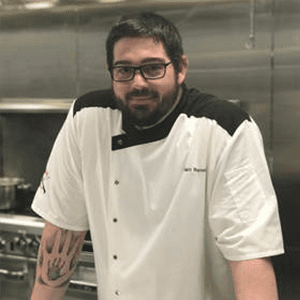Three questions, three answers — with two established hospitality experts, Matt Barone and Chris Kunisch.

Matt Barone
Chef Instructor at Kearney High School in New Jersey
Matt is an award-winning hospitality food safety expert, a chef instructor at Kearney High School in New Jersey, and a member of the Sani Professional Food Safety Advisory Council. He is an experienced chef with an entrepreneurial approach to career and technical education, focused on training students to succeed in the hospitality industry.
Chris Kumisch
Owner of Bar and Grill Restaurants in Allendale and Mahwah, New Jersey
Chris owns and operates bar and grill restaurants in Allendale and Mahwah, New Jersey, along with siblings Craig and Katie. For more than 20 years, Chris has led the operations at Allendale Bar and Grill, a successful and historic establishment. Continuing a four-generation family tradition, Chris and the Kunisch family has stayed true to its longstanding commitment to serving its guests and community.
As Covid-19 cases continue to rise, restaurants and food service establishments around the country are still grappling with how to safely and effectively operate their businesses. Many are also struggling with worker and supply shortages, which make it even more challenging to keep guests safe, and coming back. Finding creative solutions and innovative safety measures to help these operators is crucial to keeping the food industry strong and flourishing.
With many years of restaurant industry experience behind them, Matt and Chris lend practical advice and inspiring strategies to help food operators improve safety and enhance the guest experience.
1. The Covid-19 pandemic has raised consumer awareness and the need for a safe dining experience. How can operators effectively communicate the safety measures they have in place for their staff and guests?
Matt: For operators to effectively communicate both long-standing and newly implemented safety measures, they must showcase transparency to rebuild the trust with guests that COVID has eroded. This starts on the website and social media platforms by highlighting compliance for all safety policies, procedures, and guidelines that have been integrated into operations. Additionally, multimedia must be utilized to feature these practices, hence the saying that a “picture is worth a thousand words.” Finally, as word of mouth has always been our best marketing tool, incentivizing guests to provide feedback on their experience is also important. By providing a firsthand account of the safety measures in practice, guests can showcase what excellent hospitality means in the COVID era.
Chris: We implemented posters to inform our guests of the various cleaning and safety measures we were undertaking. This included all areas that were being sanitized on a regular basis throughout the day – bathrooms, tables and chairs, counters, door handles, and all other high-touch surfaces. These posters were strategically placed at the restaurant entrance, at the host’s station, and printed on the back of our menus. All our dining tables – indoor and outdoor – have been spaced out.
2. The pandemic has also led the foodservice industry into uncharted territory, prompting the need to reinvent itself. What new or creative solutions have you seen that operators can do or have done differently in the way it prepares and delivers the food experience that’s efficient, simple, safe, and satisfying?
Matt: The biggest shift within the foodservice industry during COVID appears to be the adoption and utilization of contactless technology that supports the efforts of a safe dining experience, especially within full-service and fine dining establishments. Some of the most integrated contactless technology include QR Code Menus, Online Ordering, Mobile Payment, SMS Marketing Systems, and Digital Loyalty programs. Also falling under the contactless technology umbrella are a variety of hospitality guest experience platforms. These platforms collect and utilize guest’s preferences to create a personalized marketing experience all through the smartphone. There are currently many platforms to choose from, but those with the best vitality will be the ones that focus on the value it brings to the guest.
Chris: Health guidelines were observed in a way that guests could see them in action. Our front-of-house employees were required to wear masks and gloves when serving food. Before the pandemic, it was typical for the crew to gather or huddle. That changed during the pandemic. Today, our crew practices social distancing and other safety and cleaning protocols. Technology has also been more widely adopted to promote dining safety. QR codes were made available at each table so customers can download the menu. For our older guests who have difficulty with technology, we make sure that our staff offers the needed assistance. These solutions have become important to help make guests feel safe and enable them to enjoy their dining experience.
3. As restaurants prepare for reopening, what advice would you give operators to ensure a successful reopening?
Chris: Don’t let your guard down. We are and will continue to be, in a period of uncertainty. Plan your reopening well. The labor market has been decimated, so carefully plan to staff when managing your capacity. As safety is still at the forefront of dining decisions, make sure your guidelines for cleaning, health, and safety are clear and implemented consistently. Big or small, every restaurant is going through the same challenges to serve a safe, enjoyable dining experience. We are all in this together.
Matt: The best advice I can give to ensure a successful reopening is to reconnect with both your staff and guests. This industry has always been about hospitality, and while so much has changed since the pandemic first began, making guests and staff feel welcomed and comfortable is one thing that won’t. Dining has never been just about the food, it is also the experience of the human connection.
Moving forward in today’s challenging foodservice environment will require embracing innovative strategies and new technologies to enhance safety measures. Staying informed and motivated to evolve with new innovations and processes are crucial for success.
For more information and COVID-19 resources, visit the Sani Professional COVID-19 resource center.

